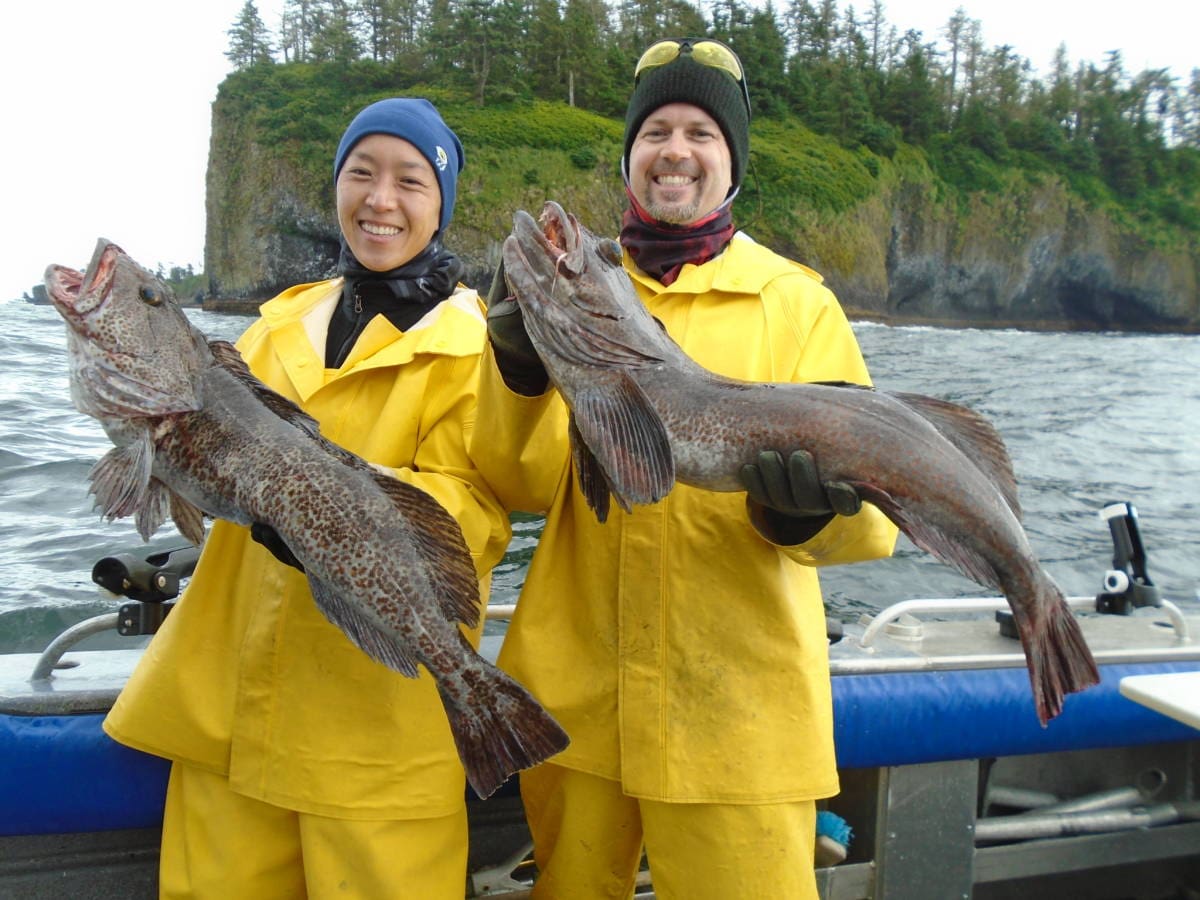 Names: Lingcod, ling, cod
Names: Lingcod, ling, cod
Range: Kodiak Island to Baja California
Size: From 12 inches to 5 feet. Current Southeast Alaska slot limit of 30 to 35 inches
World Record: 82.6 pounds
Fishing Method: Mooching, jigging, and deep water bait fishing.
WHAT TO EXPECT IN SITKA:
Season: Lings aren’t highly migratory. They are available for the catching throughout our season. They are allowed for the keeping part of the season.
Size:Lings range in size from little “pickles” under a foot long to monsters weighing up to 70 pounds that have a mouth that looks big enough to swallow a basketball. Whatever the size, you can expect an attitude from lings – if they want it, they cling on.
Techniques: Expect to catch lings incidentally while salmon mooching or halibut fishing. When lings are the target, fishing a big jig over a rocky pinnacle proves deadly. The innate aggressiveness of lingcod makes them vulnerable to all kinds of baits and jigs.
Gear: A stout 6 foot jigging rod pair with a Penn 330LD spooled with 80 pound Power Pro line works just fine. Add a 3 foot long 60 pound Berkley Vanish leader and a big lead head jig with a twister tale and you’ve got a ling catching machine. All the gear we use for lingcod is available from our favorite supplier – Ted’s Sporting Center (http://www.tedssportscenter.com) in Lynnwood, Washington.
Regulations: The season for lings is open all season. Nonresidents have an annual limit of one per day/ two per year – only one 30 to 35 inches and one greater than 55 inches. Residents may retain one lingcod daily, have two in possessions and there is no size limit.
EVERYTHING THERE IS TO KNOW ABOUT LING COD:
Lingcod range in the eastern Pacific from Ensenada in Baja California north to the Alaska Peninsula. They are popular with both sport and commercial fishermen and apparently quite susceptible to over-fishing. Puget Sound suffered a severe decline in lings during the 1970’s and eventually a moratorium on taking of lings was declared. The situation grew so dire that lings were captured on the coast and transplanted into the Sound.
The size range from lings goes from tiny pickles to monsters over 5 feet long and topping 80 pounds. They are a relatively fast growing fish reaching 12 inches in their first year. After year two, the females grow faster than the males and all the really big lings are female.
Lings spawn in late winter and early spring. The females lay eggs on rocks and in crevices in shallow water, sometimes all the way into the intertidal zone. The eggs measure roughly 3.5 millimeters in diameter after hardening due to interaction with salt water. Lingcod eggs are sticky and amass in large clusters on rocks. One book I have reports egg masses as heavy as 30 pounds on a single rock.
Lings feed on a wide variety of marine fish including herring, hake, greenling, rockfish, Pacific cod, and other lingcod to name a few. Additionally lingcod dine on crustaceans, squid, and octopus. A number of Washington commercial jig fishermen report catching lings with seabird parts in their stomachs contain various parts of sea birds. One fisherman claims that bird parts only show up lings caught near shore, never in offshore specimens.
Despite their apparent lack of fear, lingcod aren’t without enemies. Marine mammals, humans, halibut, and larger lings all dine on them. A 220 halibut landed in Neah Bay, Washington had a 32 pound ling in its gut. I’ve seen seals tossing good size ling around off the tip of the Westport, Washington jetty.
The male guards the eggs and uses the large pectoral fins characteristic of the species to fan the cluster. During the period of guarding the eggs the males are very aggressive and territorial, which makes them quite vulnerable to sport fishing because they’ll attack almost anything the enters their territory. For this reason fishing for lings during the spawning season is often restricted. These males are also very vulnerable to spear fishing. Unfortunately, when a male is pulled off the nest, the eggs stand little chance of hatching.
Northwest natives once harvested lingcod with a device called a “hee hee”. The technique employed a long spear and a shuttlecock like lure. They would use the long spear to push the shuttle cock down to the bottom. Once there they’d pull the spear back and let the buoyant shuttlecock spin its way to the surface with, hopefully, a curious lingcod in pursuit. When the ling came near, they would spear it.
Lingcod are an excellent eating fish with a nicely textured white meat that lends itself well to nearly any recipe. In the Northwest, they are frequently used for fish and chips.

